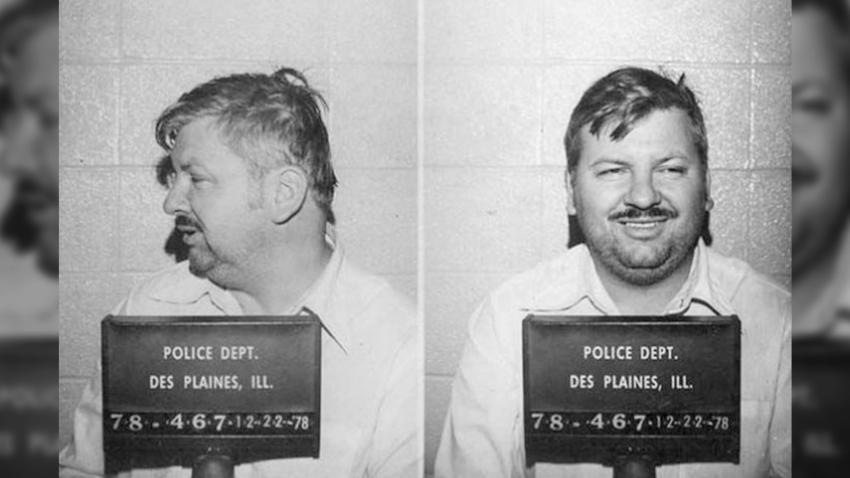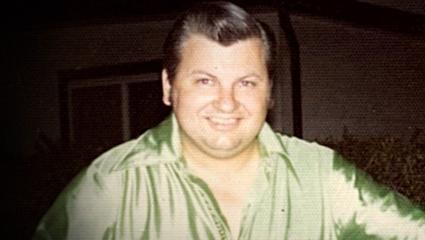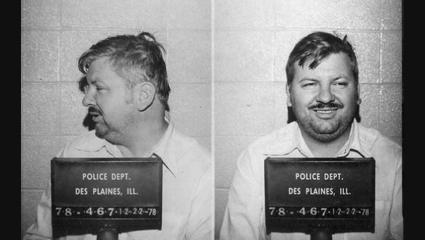
John Wayne Gacy
Killer clown, John Wayne Gacy hid 33 bodies in the crawl space under his house, as well as in rooms in his home, in trenches covered in quicklime and in a river.
Born:
17 March 1942
Hometown:
Chicago, Illinois
Date apprehended:
21st December 1978
Origins of the "Killer Clown"
John Wayne Gacy Junior was born into a middle-class, Irish Catholic family, on 17th March 1942, the second child of Marion and John Gacy Snr. He enjoyed an unremarkable childhood, apart from a playground accident aged 11, when a head blow caused him to have intermittent blackouts until he was 16.
He hero-worshipped his father, despite the fact that he was an abusive alcoholic with a violent temper, who was virulently homophobic, and who would often accuse the young Gacy of being sickly and effeminate.
Having dropped out of high school, Gacy found work difficult to come by, and he enrolled in business school where his flair for sales was soon recognised, and he excelled in his first post-graduate job as a management trainee at a footwear company in Springfield, Illinois. He also became a tireless supporter of several organisations that served the community, often dressing as a clown to entertain sick children in hospitals.
In September 1964, Gacy met and married co-worker Marlynn Myers, and his new father-in-law persuaded the newlyweds to move to Iowa, where he offered Gacy a position within a chain of fast food that he owned. Here again Gacy developed his profile in the community, by doing volunteer work within the community organisation, the Jaycees.
Marlynn later gave birth to two children, a boy and a girl, and Gacy appeared to be living the American dream, with ambitions to become Jaycee president. Cracks began to appear in the idyll, however, when rumours started to spread that Gacy was making sexual advances to young employees.
In May 1968, he was indicted for allegedly sodomising a teenage employee, Mark Miller. Gacy maintained his innocence, claiming that the sex had been consensual, and that there were factions within his Jaycee group that were fabricating evidence to spoil his chances of becoming president.
However, four months later Gacy was charged with hiring a young man, Dwight Andersson, to beat up Mark Miller. Gacy was charged and forced to undergo psychiatric evaluation. He was deemed fit for trial and decided to plead guilty to the sodomy charge. He was sentenced to ten years in prison.
His wife divorced him, and he never saw her or their children again. His adored father also died whilst he was incarcerated. While in prison Gacy was a model inmate and, amazingly, after only 18 months in the Iowa State Correctional Facility, he was released on parole on 18th June 1970. He returned to Chicago and spent four months at home with his mother.
His mother was impressed with how well her son had adjusted to life after prison and bought Gacy a ranch-style house just outside Chicago, in which she maintained a 50% interest.
He developed good relationships with his neighbours, sharing festive occasions with them. They were oblivious to his criminal conviction. Gacy had another close brush with the law, when he was charged with forcing a young boy to commit sexual acts, but the charges were dropped when the boy failed to appear at the court proceedings.
On 1st June 1972, Gacy married a divorcee with two daughters named Carole Hofgren, who was beguiled by his charm and generosity. She was aware of his prison sentence, but believed him to be a reformed character.
He maintained his work in the community and still enjoyed dressing up as a clown to entertain sick children, and appearing at children’s parties. He also enhanced his façade as the neighbourhood good guy, throwing hugely popular parties and barbecues, but increasingly people began to notice the curious smells that emanated from the floor, which Gacy blamed on moisture build-up in the crawl space under the house.
In 1974, Gacy started his own decorating business, PDM Contractors, which provided a steady supply of unsuspecting teenage employees to satisfy his impulses. He and his wife were estranged by 1975, as a result of Gacy’s violent mood swings, absence from the house most evenings, and an increasing interest in gay pornography that he no longer even bothered to hide from his wife. They divorced in March 1976.
Throughout this time Gacy’s interest in politics increased and he became involved in the Democratic Party’s election campaign, with dreams of running for public office. He impressed party officials and was promoted to a local commission, but rumours about his sexual advances towards young men, undoubtedly true, again thwarted his ambitions.
Related Articles
I lost count of how many I killed
John Wayne Gacy
The Crimes
When Gacy was eventually caught, he admitted to killing 33 boys but, given the number, was unsure of all of their names and the exact chronology. He admits to his first killing in January 1972, with his second occurring in January 1974. After his second wife’s departure in late 1975 the rate of murder escalated dramatically. He admitted to the police that he had, on a number of occasions, killed more than one boy on the same day.
Gacy's preferred approach was to invite the young men back to his home, where he would offer to show them a magic trick using 'fake' handcuffs, which were part of his clown act. Once the victims were manacled the cuffs were shown to be real, at which point he would overpower them or drug them with chloroform, then strip and gag them, often with their own underwear. Torture and rape followed, then they were either garrotted or asphyxiated by their gags.
Many of Gacy’s victims lived outside of mainstream society and worked as gay prostitutes, like Billy Carroll, but identified victims also included PDM employees, 17-year-old John Butkovich, who had a disagreement with Gacy over pay owed, and Gregory Godzik, also 17. John Szyc was an acquaintance of the PDM victims but others, like Michael Bonnin, 17, and 18-year-old Robert Gilroy, had no known reason to be in contact with Gacy.
In May 1978 one young man had a narrow escape; Jeffrey Ringall was lured into Gacy’s car with the offer of a joint, then chloroformed and taken to Gacy’s home, where he was viciously raped and tortured. For some reason, Gacy chose not to kill him, and he was left in a local park. He was hospitalised and reported the incident to the police. Dissatisfied with their response, he painstakingly retraced the route the car had taken on the night of his attack, identified Gacy’s car and spent several weeks tracking down his home, at which point he confirmed Gacy’s identity and laid charges of sexual assault against him.
The Arrest - "Killer Clown" caught
At around the same time, the disappearance of 15-year-old Robert Piest in late 1978 led police to the home of Gacy, who had apparently offered a job to the boy immediately before his disappearance. A background check revealed his earlier sodomy conviction and a search warrant was obtained for his home.
On 13th December 1978 his home was searched and a number of items were confiscated, which included drivers licences and college rings, but no bodies were discovered, although investigators noticed the strange odour which they attributed to a broken drain.
Gacy was placed under 24-hour surveillance and neighbours were questioned. Forensic evidence finally linked one of the rings found during the search to the missing boy, John Szyc, and a more extensive search of the crawl space under the house revealed the horrific extent of Gacy’s killing spree.
On 22nd December 1978, with the body count mounting, Gacy finally admitted killing at least 30 people, which included the 27 bodies found around his property, as well as a number who had been thrown in the nearby Des Plaines river, when the crawl space became too crowded to accommodate any more.
Robert Piest’s body was finally recovered from a lock on the Illinois River in April 1979. Exhaustive forensic work ensured that all but nine of Gacy’s victims were finally identified.
The Trial
Gacy’s trial opened in Chicago on 6th February 1980, with Gacy pleading guilty by reason of insanity. The prosecutor presented information about each of the 33 young victims, with testimony from friends and relatives and emphasised the premeditation and rationality of Gacy’s actions.
His defence countered that Gacy was insane, irrational and not responsible for his actions, and introduced victim Jeff Ringall as a witness, who testified to the savagery of Gacy’s attack on him. Ringall was so traumatised by reliving the attack that he broke down on the stand and had to be removed from the courtroom. They also introduced a number of psychiatric experts, who testified that Gacy had been insane at the times he had committed the murders.
The case took over five weeks to present, but the jury required only two hours to reach a guilty but sane verdict.
The Aftermath: Gacy's Evil comes to an end
On 13th March 1980 Gacy was sentenced to death and transferred to the Menard Correctional Center, where he was incarcerated on Death Row. Gacy took up oil painting, and his favourite subjects were portraits of clowns.
A number of appeals followed over the next 14 years and, with all avenues eventually exhausted, Gacy was transferred to the state penitentiary outside Chicago in May 1994. In the early hours of 10 May 1994, unrepentant to the end, John Wayne Gacy was put to death by lethal injection.
Following his execution, his paintings were sold at auction. It was reported that the winning bidder destroyed the paintings on receipt.
The Victims (not all were identified)
Tom Boling
David Talsma
Robert Winch
Russell NelsonJohn Mowery
Matthew Bowman
John Prestige
Rick Johnson
Samuel Stapleton
Randall Reffelt
Darrell Simpson
Billy Kindred
John Butkovich
Michael Bonnin
June 1976
Billy Carroll
June 1976
Gregory Godzik
December 1976
John Szyc
January 1977
Robert Gilroy
September 1977
Robert Piest
December 1978
Frank “Dale” Landingin
December 1978
James Mazzara
December 1978
Timothy O’Rourke
December 1978
Timeline
- John Wayne Gacy Born
- 17th March 1942
- Arrested
- 21st December 1978
- Trial commences
- 6th February 1978
- Convicted
- 12th March 1980
- Executed
- 10th May 1994




